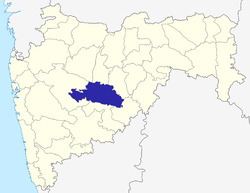Area 10,693 km² Administrative division Aurangabad division | Website Official website Tehsil 1. | |
 | ||
Tehsils 1. Beed, 2. Ashti, 3. Patoda, 4. Shirur Kasar, 5. Georai, 6. Ambajogai, 7. Wadwani, 8. Kaij, 9. Dharur, 10. Parali, 11. Majalgaon Points of interest Kankaleshwar Temple, Dharur Fort, Hatti Khana ‑ Yogeshw, Majalgaon Dam, Shivaji Statue | ||
Parli vaijnath jyothirling temple beed district maharastra india
Beed district (or Bid or Bhir) is an administrative district in the state of Maharashtra in India. The district headquarters are located at Beed. The district occupies an area of 10,693 km² and has a population of 2,585,962 of which 17.91% were urban (as of 2011).
Contents
- Parli vaijnath jyothirling temple beed district maharastra india
- Map of Beed Maharashtra
- History
- Economy
- Divisions
- Demographics
- References
Map of Beed, Maharashtra
History
Beed district has a long history of many rulers and kingdoms. In the ancient era, this city was called as Champavati nagari. The city still proudly shows some old monuments showing the signs of past glory in the form of many city entry doors (called Ves in local language) and city protection walls. Until the 19th century, this part of Marathwada was under the Nizam monarchy, but was later included into the Indian Republic after a fierce struggle between Indian freedom fighters and Nizam soldiers. THE name of Bhir is given by Mohammad Tughlaq.
Economy
Agriculture is the main business in Beed, and it is largely dependent on monsoon rain. Beed also is a district which provides a large number of laborers in India.
Divisions
This district is divided into eleven talukas (or tehsils). These are:
Demographics
According to the 2011 census Beed district has a population of 2,585,962, roughly equal to the nation of Kuwait or the US state of Nevada. This gives it a ranking of 160th in India (out of a total of 640). The district has a population density of 242 inhabitants per square kilometre (630/sq mi) . Its population growth rate over the decade 2001-2011 was 19.65%. Bid has a sex ratio of 912 females for every 1000 males, and a literacy rate of 73.53%.
